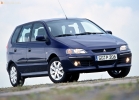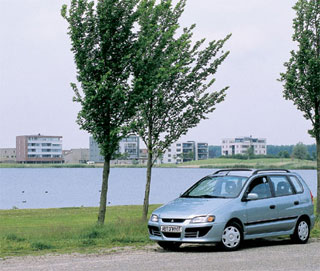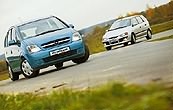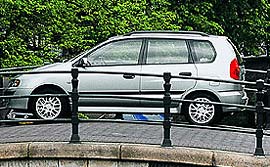Test Drive Mitsubishi Space Star 2002 - 2006 Minivan
Silver asterisk
Japan is a country not only the rising sun. There's something new that is born there is something new, or even a revolutionary, what the rest of the world is often not ready. And only after some time, waking up, he begins to crash up.The wave of universal mini-platitudes only relatively recently reached Europe (Peugeot 307, Citroen C3 ...). And the speech here is not about minibies as such, but about the hatchbacks with a raised roof - the Japanese are so called this cars, or in our opinion - about the wagons of high capacity. They occupy a place between hatchbacks (wagons) and actually mini-Wenni and differ from the latter more passenger outlines of the body. For this, they are also called half and a half two. And, as usual, the sunrise of such cars in Japan began much earlier than anywhere else - in the late 80s.
The pioneer is considered to be a company Mitsubishi. Its most famous and sold in Europe model Space Runner (7-seater version - Space Wagon) saw the light in 1991. In 1998, the Geneva showed a new one - Space Star (it is a little more than Space Runner, and Space Wagon is now an independent model). She was built on the Mitsubishi Carisma platform with a shortened base, which was produced for three years. Like Carisma, Space Star is an absolutely European car, its production has been established in the Netherlands at the Nedcar plant. Now the company is fully owned by Mitsubishi Motor Co. "After she in 2000 bought 50% of his shares from a partner - Volvo. Meanwhile, 37.4% of Mitsubishi shares belong to DaimlerChrysler, in connection with which the change of red rubies on the company's models on silver-steel crystals looks quite logical ...
The presentation of the updated version of Space Star took place at the beginning of the summer of this year in the Netherlands, in fact in the homeland. If we talk about appearance, the main changes touched the front part - new optics, bumper, hood. Something she resembles Fiat Stilo. Rearly new, perhaps, only lanterns. Moldings and doors handles are now in the color of the body do not paint - they are black. The design outstanding and original will not call, but in general everything is quite modern, it should be enough for a couple of years.
Updating the interior, also showed modesty. Materials, colors are chosen so that the salon looks solid, more expensive. The new steering wheel (diameter is reduced from 386 to 370 mm) is beautiful and convenient. He, as before, is rocked in a bus and adjustable only on the corner of the tilt. The seats are completely mechanical - you can set the height of the pillow and the angle of the backrest. Impressive range of longitudinal adjustment - even the longest-legged ...
There is no comments to the location and execution of management bodies. The central console changed slightly - now the header of the stereo system is hiding under the lid, as well as an additional drawer under the three rotating handles, which are responsible for the operation of the air conditioner. The latter is now included in standard equipment. Climate control is not yet provided. Power windows of all doors are electrical, regardless of the configuration.
Three rear head restraints hint at the five-dimensional machine - this can be realized, but will be closed. Along there is better there, and the armrest with the cup holders will have to be. In addition, despite the fact that the head restraints are now holey, medium looming in the rearview mirror, worsening visibility. Foot places and above is plentiful, even if you decide to increase the volume of the trunk (370 to 450 liters) and shift the rear row (150 mm).
Much more new in technical terms. 1.6 liters of 98 hp gasoline was added to the 1,3-liter motor. (since last year) and 1.9-liter 115-strong diesel. But the 1.8-liter 125-strong GDI with the direct fuel injection on Space Star decided not yet to put - they say, early until it understood it in Europe. Instead, an engine is offered an engine of the same volume, with a capacity of 112 hp, but with the traditional MPI injection system (MULTI Point Injection). Two 1,6 liter gasoline engine besides mechanics are aggregated with a new four-step automatic machine with manual mode.
The first Space Star got me with Diesel and Mechanics and was distinguished by stunning elasticity and tolerance for errors in choosing a transfer. What at first helped a lot - the box provides clear short switching, but the gears are located close, and I often come to the third with unaccustomer instead. However, diesel without a hint at the stop accelerated the car from the spot even to the mountain and at the same time eagerly spinled to 4500 rpm. Unfortunately, the diesel version will not be supplied to Russia, at least as long as. Modern diesel engines are very demanding about the quality of fuel and service, and it leaves much to be desired in our country.
The 1.8-liter gasoline engine is somewhat inferior to diesel in elasticity and even in a dynamics, although it is spinning with ease of up to 6000 rpm. It affects the lack of moment on the Nizakh - 157 nm at 4000 rpm. against 265 nm at 1800-2500 rpm.
The 1.6-liter engine is quite adequately coping with its duties, allows you to fit into the city stream without much difficulty in the left strip of the country highway, confidently keeping the speed of 150-170 km / h. In the cabin at the same time, the truth is noisy.
All three engines get well and with a machine gun, even a kid with a volume of 1.6 liters. Switching timely and smooth, almost without hanging on maximum speed. Manual mode is useful when clothing on the highway, especially considering the small volume of the proposed motors. Braking engine is ineffective, especially in a gasoline version. But in general, the machine is useful in the city of the thing, especially in such as Amsterdam, where the presentation was held - there are full of traffic lights on the rises and steep little streets, sising cyclists.
Handling is simultaneously safe and comfortable. Movement in a straight line confident, almost to maximum speeds. The steering wheel of an elastic and clear. There is a slight insufficient turning, without difficulty corrected by the discharge of gas and the steering wheel. Rolls are too long, but quite acceptable for a similar machine. This is more than compensated by the excellent smoothness of the stroke - the suspension imperceptibly swallows all small irregularities. Easy routine of the body begins when the speed exceeds 150 km / h.
Cars with increased 15 mm clearance will be supplied to Russia. Also eliminated flawed - increased the course of the penalty, earlier it was insufficient due to the extensioning stroke of compression, the consequence of which there were unpleasant blows when the suspension was carried out.
Brakes at height - work effectively, effort on pedals are adequate. Noise insulation as a whole is good, but after hundreds begin to whistle whishers, then it is accepted to solo the engine, while, oddly enough, the diesel appeared to the most quiet from the triple of motors.
In general, the impression of Space Star is good. Everything in it is as necessary - by and large even to complain about nothing. A good family car is no longer a hatchback, but not yet mini-Ven. Marketers logically attribute it to the golf class (segment C), but not only in Russia, where Space Star will compete with cars such as Renault Scenic or Citroen Xsara Picasso ...
Space Star sales in Russia began at the end of June - this applies to the 1.6-liter version (from $ 15,900). 1.8-liter (from $ 17.990) will appear in October. And 1,3-liter and diesel options in our country will not be delivered at all. It is worth noting that on official channels in 2002 it is supposed to sell more than 500 Space Star (against 166 in the past). All prerequisites for this are available.
Text: Sergey Yakubov
A source: Magazine Motor [№2 / 2002]
Video crash tests Mitsubishi Space Star 2002 - 2006
Test Drives Mitsubishi Space Star 2002 - 2006
Crash Test Mitsubishi Space Star 2002 - 2006
Crash Test: Details20%
Driver and passengers
14%
Pedestrians











